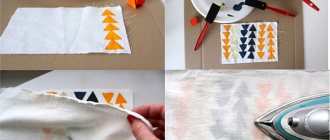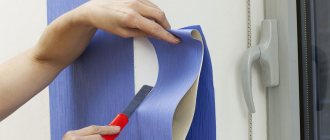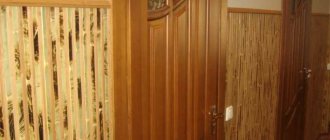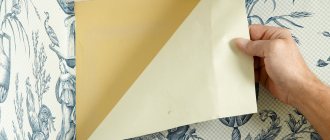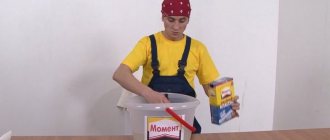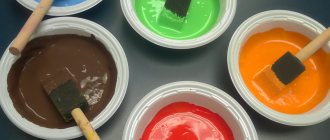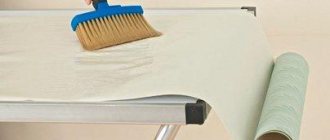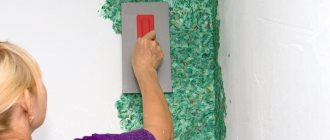Beautiful wallpaper with a pattern pleases the eye, decorates the room, and is an element of a certain style in the interior. This is the most used and affordable finishing material.
The technology for its production is constantly being improved. New high-quality types of wallpaper of various widths are appearing, colors are being updated, and the range is expanding. Prices are presented for buyers with different financial capabilities.
Many people do the wallpapering themselves, and invest the money they save in better quality material. The main thing is to buy the right number of rolls. To do this, you need to understand how to adjust the wallpaper pattern without unnecessary trimmings and waste.
They will still be there. But you can cut canvases with small strips of waste or pieces into the floor - walls. Depending on the area of the surface to be pasted, you can save 1 roll or more on adjustment.
When choosing a wallpaper pattern
If you want the choice to be more economical, then focus on the location of the images and its theme. As an example, I will give examples of a wallpaper line where selection for joining is not required:
- Solid colors with no image at all. To the plain ones you can add canvases without a clear picture - intricate figures, polka dots, specks, just texture, etc.;
- Striped prints. Vertical orientation;
- Abstract motifs - random strokes, irregularly shaped spots, balls, etc., located chaotically.
If we consider how to properly glue wallpaper with the selection of a pattern, then the main thing here is to perfectly match the pattern, connecting the stripes.
Combining the drawing is mandatory:
- Horizontal and diagonal strips are glued with a selection of patterns;
- Elements of natural decor - floral arrangements, branches with leaves, flowers, exotic vegetation;
- Geometric shapes in the form of rhombuses, ellipses, rectangular figures of different volumes and shapes;
- Complex ornaments, imitation of expensive fabric products, embroideries that create a large and rich design require careful joining.
To summarize, logic dictates, and practice confirms:
The smaller the repeat value, the more often the same element for joining will be repeated. And, conversely, if its value is large, you will have to buy a larger meter of wallpaper.
The finer the pattern, the less waste you create.
If, in any case, you chose what you like, then the extra footage purchased will not change the weather.
Tools
To cut wallpaper, you can use a knife with a segment blade, which is commonly used for cutting drywall, plastic, and stripping electrical wires. With this tool you can cut the wallpaper lengthwise and crosswise without much difficulty.
To cut the wallpaper as accurately as possible, you will also need to purchase a 1.2-1.5 m long spirit level, which will be used as a ruler. However, it is easier and cheaper to use an ordinary rule or wedge. To trim the edges of the wallpaper, you will need sharp, medium-length scissors (up to 200 mm).
Preparatory stage
At this stage, you must decide on the volume and sequence of work to be performed, calculate and purchase the required materials. But first of all, prepare the base of the wall surface or ceilings for finishing
As a rule, this is a typical set of works. Remove the previous wallpaper or other covering and assess the condition of the base. If you find cracks or uneven areas, putty them after applying the primer.
After the putty composition has dried, go over it with a sanding mesh or sandpaper. Prime the surface again. The base is ready. Now prepare the wallpaper by selecting a pattern for cutting.
Video
You can see in practice how to glue and trim wallpaper in the corners by watching the video:
Additional recommendations for cutting wallpaper:
Before you start pasting the walls, you should trim the edges of the wallpaper, if any. After this, it is important to cut the wallpaper correctly. To do this, markings are made along which the canvas will be cut. If there is a pattern on the wallpaper, then it must be joined correctly. How to cut wallpaper? How to join a drawing? What do you need to consider when doing these cutting jobs? This will be discussed in the article.
How to cut wallpaper to fit the pattern
The production of the material is put on stream, so the wallpaper tape moving along the conveyor is cut mechanically to the specified roll dimensions. If you're a beginner, you might feel confused about where to start.
Everything is quite simple, since the pattern is repeated in equal steps. This is what the fitting principle is based on. This is precisely the basis of the sticker - how to properly glue wallpaper with the selection of a pattern. I'll share how it's done.
Calculate the number of rolls in advance and buy them. All measuring processes are easier to do on a clean floor. Initially, you need to measure the height of the room in several places. For example, the height of the room is 250 cm - this is what we will proceed from when cutting.
Unroll several rolls to select the top. This will be the guideline. Next, mark the desired height (2.5 meters). Now you need to find exactly the same top further down the roll. This could be the beginning of a pattern, flower or geometric element. Tag it. We are preparing a template according to which we will cut out all the other strips. The end result is that the top is the same everywhere, and when the bottom is cut off, the next strip starts from the top of the next strip.
Let's move on to the next roll. Again we find the top taken as a basis, cut it off evenly and, according to the template made earlier, set aside the required size. This way you will cut out all the wallpaper with a selection of patterns for the entire room. They should be more than 2.5 meters in height; the excess is cut off.
Some craftsmen don’t get hung up on preliminary cutting, but, saving time, manage to glue wallpaper by adjusting the pattern on the wall. After sticking the first strip, apply a roll to it, look for the desired fragment of a match, cut it off and stick it on. How to properly glue wallpaper with the selection of a pattern involves correct calculation, combination of illustrations, and obtaining an image without distortion.
To reduce waste, sometimes you have to apply not one roll, but several, to find the smallest repeat. Having chosen the appropriate one, it is used to select a pattern. Most of us carefully measure everything, and then glue the finished blanks according to the standard pattern.
Slicing rules
The canvas is adjusted along the front side. This requires choosing a memorable, distinct element. It is from this that the top edge of the strip is measured. The product is measured in two ways:
- Spread part of the roll on the reverse side, calculate the quantity, making a 5-centimeter reserve on each side. Typically, monochromatic options are sized this way.
- Spread the roll right side out. They make stripes, joining patterns and ornaments by hand.
How to cut wallpaper with pattern selection
To work, you will need a paint knife with a new blade inserted. Fold the first strip (template) along the mark so that its edges coincide with the edges of the main roll. This ensures a rectangular cut. Press down well on the bend, as when cutting paper. Now you can safely cut along the fold.
Cut the next strips in the same way, placing the template on top and marking the desired size. To control the selection of the pattern, place newly cut pieces of trellis next to each other from time to time and make sure that they are cut correctly.
The remaining waste is already matched in size in places behind heating radiators, above door and window openings. It is more convenient to select a pattern in these places after gluing all the entire stripes.
Cutting tools
If you choose a knife to cut wallpaper, it should be easy to use and as sharp as possible. Knives with segmented blades have these properties. Typically, they are used for cutting drywall. With this tool you can cut plastic, drywall, strip wires and even sharpen construction pencils. With its help, it is convenient to cut wallpaper and trim them in the corners.
For high-precision cutting you need to get a ruler. It should be long enough. In addition, it should be convenient to guide the knife along it. A construction spirit level with a length of 1.2-1.5 m can play this role. With its help, you can guarantee pressing of the blade along the entire length, safe and accurate cutting, as well as ease of operation.
Some craftsmen prefer to use scissors to cut wallpaper. Well, perhaps this is not the worst option. You can use almost any of their analogues, with the exception of manicure ones. Scissors must be of medium length and must be sharp. Hairdressing or household scissors will do.
Wallpapering with pattern selection
- All the wallpaper sheets are ready, all that remains is to dilute the adhesive according to the instructions for it. Remove sockets, switches, and turn off the power supply in this room. Drafts must be excluded. We will describe step by step how to properly glue wallpaper and select a pattern.
- To ensure that the vertical is maintained and the strips are not skewed in any direction, we draw a line on the wall along the level, which will be the beginning of the pasting. If the backing is non-woven, then the work will be completed faster, since you will only have to spread the glue on the wall. With a paper base, glue is applied to the wall and the back of the sheets too.
- Aligned trellises are easier to glue with a helper, because when you place the sheet at the top, your partner helps you align the picture correctly. Glue the first sheet strictly along the intended line, carefully smoothing it out, squeezing out excess air to avoid bubbles.
- Apply the second strip to the first and watch the joining of the strip itself, since the sticker goes end-to-end. If the wallpaper has a large pattern, be especially careful, as any deviation is immediately noticeable. Having smoothed this sheet well, we move on. Having reached the corner, the question involuntarily arises: how to glue wallpaper with a pattern in the corners if they are uneven?
- There is a technology here. Using a tape measure, measure the distance from the end of the last glued sheet to the corner and, adding 2-3 cm to the result, cut a piece and glue it. On the second side of the corner, glue a full-fledged panel with a selection of patterns in the corner, overlapping these 2-3 cm. Using a knife on a wide spatula, cut through the center of the corner and remove this narrow strip and smooth out the joint.
Using this principle, you cover the entire room, cutting off the excess from the top and bottom. How to properly glue wallpaper with the selection of a pattern is not such a difficult task; you can completely master this process with your own hands, no matter how complex the pattern is.
Pasting and trimming wallpaper on outer corners
External corners are also found in rooms. These could be door/window slopes. If you have to wallpaper smooth slopes, then everything is simple. So, stick the wallpaper on one side so that the edge of the sheet overlaps the adjacent wall by about 4 cm. Align and smooth the sheet of wallpaper. If folds and bubbles appear, make several small horizontal cuts on the wallpaper sheet.
Next, trim the folded edge of the sheet so that a small edge remains. Measure the next sheet to work with and glue it to the slope. So, you will get a slight overlap. If you are covering vinyl wallpaper, you should use special glue in the overlapping areas.
Pasting external corners
We hope that the information we provided was useful to you. If you have any questions while reading the material, you can ask our expert. Would you like to comment on what you read? In this case, write to us. You can leave comments at the end of the article.
Preparing to cut wallpaper yourself
Necessary tools for cutting wallpaper
- Wallpaper knife - used for cutting rolled wallpaper into separate panels. As a tool for cutting wallpaper, you can use construction knives, a stationery knife, or simply any suitable knife with a sharp blade.
- Circular cutter - has one or two sliding edges and is designed for cutting wallpaper with wet adhesive in places that are inconvenient for conventional tools (plinths, window sills, trim, etc.). This tool is most often used by professionals, but it is very convenient and can be useful for correcting defects when cutting panels. In addition, it is excellent for cutting panels when cutting.
- Scissors - also used as a tool for cutting wallpaper rolls into individual panels. The blades of the scissors must be of sufficient length (up to 200 mm) and have a sharp, correct sharpening, otherwise the cutting edge will be uneven and the edges will be tousled.
- A metal ruler, a tape measure and a square are measuring instruments that are used, respectively, to carry out all the necessary measurements and mark the wallpaper panels when cutting them. You can also use a building level (like a metal ruler) 1.2-1.5 m long.
- Marking tool - a pencil or marker for marking wallpaper sheets when cutting them and applying appropriate marks on the walls.
Preparing the work surface for cutting wallpaper
The working surface is the place where the wallpaper roll will be unrolled and cut into separate panels. This can be a table of suitable size, a wooden sheet (fibreboard, chipboard) laid on stands (stools) or a prepared section of the floor. The floor or other surface can be covered with paper or a suitable sheet of cardboard or plywood. The surface must be stable, level and clean (otherwise the wallpaper sheet may be torn or stained). In addition, it is necessary to take into account that the working surface will be subject to cuts from the knife when cutting wallpaper.
In the future, this work surface can be used for laying, in the order of use, prepared sheets of wallpaper and applying glue to the panels before pasting.
